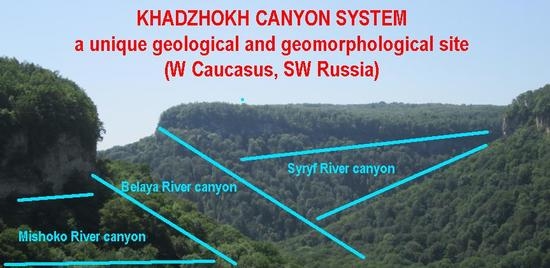The Khadzhokh Canyon System—An Important Geosite of the Western Caucasus
Abstract
1. Introduction
2. Geographical and Geological Setting
2.1. Geographical Setting
2.2. Geological Setting
3. Methodology
4. Results
4.1. Geosite Outline
4.2. Dominant Geoheritage Type
4.3. Non-Dominant Geoheritage Types
4.4. Other Geosite Characteristics
5. Discussion and Conclusion
Author Contributions
Funding
Acknowledgments
Conflicts of Interest
References
- Brilha, J. Inventory and quantitative assessment of geosites and geodiversity sites: A review. Geoheritage 2016, 8, 119–134. [Google Scholar] [CrossRef]
- Henriques, M.H.; Pena dos Reis, R.; Brilha, J.; Mota, T. Geoconservation as an Emerging Geoscience. Geoheritage 2011, 3, 117–128. [Google Scholar] [CrossRef]
- Prosser, C.; Murphy, M.; Larwood, J. Geological Conservation: A Guide to Good Practice; English Nature: Peterborough, UK, 2006. [Google Scholar]
- Reynard, E.; Brilha, J. (Eds.) Geoheritage: Assessment, Protection, and Management; Elsevier: Amsterdam, The Netherlands, 2018. [Google Scholar]
- Ruban, D.A. Quantification of geodiversity and its loss. Proc. Geol. Assoc. 2010, 121, 326–333. [Google Scholar] [CrossRef]
- Štrba, L.; Rybar, P.; Balaz, B.; Molokac, M.; Hvizdak, L.; Krsak, B.; Lukac, M.; Muchova, L.; Tometzova, D.; Ferencikova, J. Geosite assessments: Comparison of methods and results. Curr. Issues Tour. 2015, 18, 496–510. [Google Scholar] [CrossRef]
- Wimbledon, W.A.P.; Smith-Meyer, S. (Eds.) Geoheritage in Europe and its conservation; ProGEO: Oslo, Norway, 2012. [Google Scholar]
- Brilha, J.; Gray, M.; Pereira, D.I.; Pereira, P. Geodiversity: An integrative review as a contribution to the sustainable management of the whole of nature. Environ. Sci. Policy 2018, 86, 19–28. [Google Scholar] [CrossRef]
- Ruban, D.A.; Tiess, G.; Sallam, E.S.; Ponedelnik, A.A.; Yashalova, N.N. Combined mineral and geoheritage resources related to kaolin, phosphate, and cement production in Egypt: Conceptualization, assessment, and policy implications. Sustain. Environ. Res. 2018, 28, 454–461. [Google Scholar] [CrossRef]
- Dowling, R.; Newsome, D. (Eds.) Handbook of Geotourism; Edward Elgar: Cheltenham, UK, 2018. [Google Scholar]
- Hose, T.A. 3G’s for Modern Geotourism. Geoheritage 2012, 4, 7–24. [Google Scholar] [CrossRef]
- Olafsdottir, R.; Tverijonaite, E. Geotourism: A Systematic Literature Review. Geosciences 2018, 8, 234. [Google Scholar] [CrossRef]
- Bradbury, J. A keyed classification of natural geodiversity for land management and nature conservation purposes. Proc. Geol. Assoc. 2014, 125, 329–349. [Google Scholar] [CrossRef]
- Bruschi, V.M.; Cendrero, A. Geosite evaluation; can we measure intangible values? Alp. Mediterr. Quat. 2005, 18, 293–306. [Google Scholar]
- Fernández, M.P.; Timón, D.L.; Marín, R.G. Geosites Inventory in the Geopark Villuercas-Ibores-Jara (Extremadura, Spain): A Proposal for a New Classification. Geoheritage 2014, 6, 17–27. [Google Scholar] [CrossRef]
- Habibi, T.; Ponedelnik, A.A.; Yashalova, N.N.; Ruban, D.A. Urban geoheritage complexity: Evidence of a unique natural resource from Shiraz city in Iran. Resour. Policy 2018, 59, 85–94. [Google Scholar] [CrossRef]
- Miljkovic, D.; Božic, S.; Miljkovic, L.; Markovic, S.B.; Lukic, T.; Jovanovic, M.; Bjelajac, D.; Vasiljevc, D.A.; Vujicic, M.D.; Ristanovic, B. Geosite Assessment Using Three Different Methods; A Comparative Study of the Krupaja and the Žagubica Springs-Hydrological Heritage of Serbia. Open Geosci. 2018, 10, 192–208. [Google Scholar] [CrossRef]
- Migoń, P.; Pijet-Migoń, E. Viewpoint geosites—Values, conservation and management issues. Proc. Geol. Assoc. 2017, 128, 511–522. [Google Scholar] [CrossRef]
- Ruban, D.A. Geological Heritage of the Anthropocene Epoch—A Conceptual Viewpoint. Heritage 2020, 3, 19–28. [Google Scholar] [CrossRef]
- Štrba, L.; Baláž, B.; Lukác, M. Roadside geotourism—An alternative approach to geotourism. e-Rev. Tour. Res. 2016, 13, 589–609. [Google Scholar]
- Ruban, D.A.; Pugachev, V.I. The Khadzhokhsky canyon and the Granitnoye gorge (Adygeia, Russia) as geological natural monuments. Geogr. Nat. Resour. 2008, 29, 50–53. [Google Scholar] [CrossRef]
- Ahnert, F. The influence of Pleistocene climates upon the morphology of cuesta scarps on the Colorado plateau. Ann. Assoc. Am. Geogr. 1960, 50, 139–156. [Google Scholar] [CrossRef]
- Barlow, J. Rock creep and the development of the Niagara Cuesta. Earth Surf. Process. Landf. 2002, 27, 1125–1135. [Google Scholar] [CrossRef]
- Davis, W.M. The Drainage of Cuestas. Proc. Geol. Assoc. 1899, 16, 75–93. [Google Scholar] [CrossRef]
- Duszynski, F.; Migoń, P.; Strzelecki, M.C. Escarpment retreat in sedimentary tablelands and cuesta landscapes—Landforms, mechanisms and patterns. Earth-Sci. Rev. 2019, 196, 102890. [Google Scholar] [CrossRef]
- Hübscher, C.; Borowski, C. Seismic evidence for fluid escape from Mesozoic cuesta type topography in the Skagerrak. Mar. Pet. Geol. 2006, 23, 17–28. [Google Scholar] [CrossRef]
- Jungerius, P.D.; Van Zon, H.J.M. The formation of the Lias cuesta (Luxembourg) in the light of present-day erosion processes operating on forest soils. Geogr. Ann. Ser. A 1982, 64, 127–140. [Google Scholar] [CrossRef]
- Peterek, A.; Schröder, B. Geomorphologie evolution of the cuesta landscapes around the Northern Franconian Alb—Review and synthesis. Z. Für Geomorphol. 2010, 54, 305–345. [Google Scholar] [CrossRef]
- Pinheiro, M.R.; Queiroz Neto, J.P.D. From the semiarid landscapes of southwestern USA to the wet tropical zone of southeastern Brazil: Reflections on the development of cuestas, pediments, and talus. Earth-Sci. Rev. 2017, 172, 27–42. [Google Scholar] [CrossRef]
- Schmidt, K.-H.; Meitz, P. Cuesta scarps on the Colorado Plateau, USA—Lithological and climatic control in different altitudinal belts. Erde 2000, 131, 181–204. [Google Scholar]
- Ward, D.J. Dip, layer spacing, and incision rate controls on the formation of strike valleys, cuestas, and cliffbands in heterogeneous stratigraphy. Lithosphere 2019, 11, 697–707. [Google Scholar] [CrossRef]
- Adamia, S.; Zakariadze, G.; Chkhotua, T.; Sadradze, N.; Tsereteli, N.; Chabukiani, A.; Gventsadze, A. Geology of the Caucasus: A review. Turk. J. Earth Sci. 2011, 20, 489–544. [Google Scholar]
- Rolland, Y. Caucasus collisional history: Review of data from East Anatolia to West Iran. Gondwana Res. 2017, 49, 130–136. [Google Scholar] [CrossRef]
- van Hinsbergen, J.J.; Torsvik, T.H.; Schmid, S.M.; Matenco, L.C.; Maffione, M.; Vissers, R.L.M.; Gürer, D.; Spakman, W. Orogenic architecture of the Mediterranean region and kinematic reconstruction of its tectonic evolution since the Triassic. Gondwana Res. 2020, 81, 79–229. [Google Scholar] [CrossRef]
- Vasey, D.; Cowgill, E.; Roeske, S.M.; Niemi, N.A.; Godoladze, T.; Skhirtladze, I.; Gogoladze, S. Evolution of the Greater Caucasus Basement and Formation of the Main Caucasus Thrust, Georgia. Tectonics 2020, 39, e2019TC005828. [Google Scholar] [CrossRef]
- Yin, A. Cenozoic tectonic evolution of Asia: A preliminary synthesis. Tectonophysics 2010, 488, 293–325. [Google Scholar] [CrossRef]
- Gaetani, M.; Garzanti, E.; Poline, R.; Kiricko, Y.; Korsakhov, S.; Cirilli, S.; Nicora, A.; Rettori, R.; Larghi, C.; Bucefalo Palliani, R. Stratigraphic evidence for Cimmerian events in NW Caucasus (Russia). Bull. De La Société Géologique De Fr. 2005, 176, 283–299. [Google Scholar] [CrossRef]
- Ruban, D.A.; Zerfass, H.; Pugatchev, V.I. Triassic synthems of southern South America (southwestern Gondwana) and the Western Caucasus (the northern Neotethys), and global tracing of their boundaries. J. South Am. Earth Sci. 2009, 28, 155–167. [Google Scholar] [CrossRef]
- Rostovtsev, K.O.; Agaev, V.B.; Azarian, N.R.; Babaev, R.G.; Beznosov, N.V.; Hassanov, N.A.; Zesashvili, V.I.; Lomize, M.G.; Paitschadze, T.A.; Panov, D.I.; et al. Yura Kavkaz; Nauka: St. Petersburg, Russia, 1992. (In Russian) [Google Scholar]
- Adamia, S.; Alania, V.; Chabukiani, A.; Kutelia, Z.; Sadradze, N. Great Caucasus (Cavcasioni): A Long-lived North-Tethyan Back-Arc Basin. Turk. J. Earth Sci. 2011, 20, 611–628. [Google Scholar]
- Ershova, A.V.; Brunet, M.-F.; Nikishin, A.M.; Bolotov, S.N.; Nazarevich, B.P.; Korotaev, M.V. Northern Caucasus basin: Thermal history and synthesis of subsidence models. Sediment. Geol. 2003, 156, 95–118. [Google Scholar] [CrossRef]
- Guo, L.; Vincent, S.J.; Lavrishchev, V. Upper Jurassic Reefs from the Russian Western Caucasus: Implications for the Eastern Black Sea. Turk. J. Earth Sci. 2011, 20, 629–653. [Google Scholar]
- Kuznetsov, V.G. Late Jurassic—Early Cretaceous carbonate platform in the northern Caucasus and Precaucasus. Am. Assoc. Pet. Geol. Mem. 1993, 56, 455–463. [Google Scholar]
- Jasamanov, N.A. Landshaftno-klimatitchieskije uslovija jury, mela i paleogena Juga SSSR; Nedra: Moskva, Russia, 1978. (In Russian) [Google Scholar]
- Lubova, K.A.; Zayats, P.P.; Ruban, D.A.; Tiess, G. Megaclasts in geoconservation: Sedimentological questions, anthropogenic influence, and geotourism potential. Geologos 2013, 19, 321–335. [Google Scholar] [CrossRef]
- Mikhailenko, A.V.; Ruban, D.A. Geo-Heritage Specific Visibility as an Important Parameter in Geo-Tourism Resource Evaluation. Geosciences 2019, 9, 146. [Google Scholar] [CrossRef]
- Mikhailenko, A.V.; Nazarenko, O.V.; Ruban, D.A.; Zayats, P.P. Aesthetics-based classification of geological structures in outcrops for geotourism purposes: A tentative proposal. Geologos 2017, 23, 45–52. [Google Scholar] [CrossRef]
- Fuertes-Gutiérrez, I.; Fernández-Martínez, E. Geosites Inventory in the Leon Province (Northwestern Spain): A Tool to Introduce Geoheritage into Regional Environmental Management. Geoheritage 2010, 2, 57–75. [Google Scholar] [CrossRef]
- Mucivuna, V.C.; Reynard, E.; Garcia, M.G.M. Geomorphosites Assessment Methods: Comparative Analysis and Typology. Geoheritage 2019, 11, 1799–1815. [Google Scholar] [CrossRef]
- Sinnyovsky, D.; Sachkov, D.; Tsvetkova, I.; Atanasova, N. Geomorphosite Characterization Method for the Purpose of an Aspiring Geopark Application Dossier on the Example of Maritsa Cirque Complex in Geopark Rila, Rila Mountain, SW Bulgaria. Geoheritage 2020, 12, 26. [Google Scholar] [CrossRef]
- Warowna, J.; Zglobicki, W.; Kolodynska-Gawrysiak, R.; Gajek, G.; Gawrysiak, L.; Telecka, M. Geotourist values of loess geoheritage within the planned Geopark Malopolska Vistula River Gap, E Poland. Quat. Int. 2016, 399, 46–57. [Google Scholar] [CrossRef]
- Scheidegger, A.E.; Hantke, R. On the genesis of river gorges. Trans. Jpn. Geomorphol. Union 1994, 15, 91–110. [Google Scholar]
- Lozovoj, S.P. Lagonakskoe nagor’e; Krasnodarskoe knizhnoe izdatel’stvo: Krasnodar, Russia, 1984. (In Russian) [Google Scholar]
- Bakalowicz, M. Epikarst Processes. Treatise Geomorphol. 2013, 6, 164–171. [Google Scholar]
- Jones, W.K. Physical structure of the epikarst. Acta Carsologica 2013, 42, 311–314. [Google Scholar] [CrossRef]
- Ginés, A.; Knez, M.; Slabe, T.; Dreybrodt, W. (Eds.) Karst rock features: Karren scuplturing; Karst Research Institute ZRC SAZU: Ljubljana, Slovenia, 2009. [Google Scholar]
- Veress, M. Morphology and solution relationships of three karren slopes in different environments (Totes Gebirge, Eastern Alps). Z. Für Geomorphol. 2012, 56, 47–62. [Google Scholar] [CrossRef]
- Veress, M. The karren and karren formation of bare slopes. Earth-Sci. Rev. 2019, 188, 272–290. [Google Scholar] [CrossRef]
- Veress, M.; Péntek, K. Theoretical model of surface karstic processes. Z. Für Geomorphol. 1996, 40, 461–476. [Google Scholar]
- Williams, P.W. The role of the epikarst in karst and cave hydrogeology: A review. Int. J. Speleol. 2008, 37, 1–10. [Google Scholar] [CrossRef]
- Alberti, M.; Fürsich, F.T.; Pandey, D.K. Deciphering condensed sequences: A case study from the Oxfordian (Upper Jurassic) Dhosa Oolite member of the Kachchh Basin, western India. Sedimentology 2013, 60, 574–598. [Google Scholar] [CrossRef]
- Föllmi, K.B. Sedimentary condensation. Earth-Sci. Rev. 2016, 152, 143–180. [Google Scholar]
- Gómez, J.J.; Fernández-López, S. Condensation processes in shallow platforms. Sediment. Geol. 1994, 92, 147–159. [Google Scholar] [CrossRef]
- Dzyuba, O.S.; Goryacheva, A.A.; Ruban, D.A.; Gnezdilova, V.V.; Zayats, P.P. New data on Callovian (Middle Jurassic) belemnites and palynomorphs from the Northwestern Caucasus, southwest Russia. Geologos 2016, 22, 49–59. [Google Scholar] [CrossRef]
- Vorob’ev, I.E. Poisk iskopaemykh na Severo-Zapadnom Kavkaze. Krasnodarskij kraj i Respublika Adygeja; KO RosGeo: Krasnodar, Russia, 2014. (In Russian) [Google Scholar]
- Haq, B.U. Triassic Eustatic Variations Reexamined. GSA Today 2018, 28, 4–9. [Google Scholar] [CrossRef]
- Blair, T.C.; McPherson, J.G. Grain-size and textural classification of coarse sedimentary particles. J. Sediment. Res. 1999, 69, 6–19. [Google Scholar] [CrossRef]
- Blott, S.J.; Pye, K. Particle size scales and classification of sediment types based on particle size distributions: Review and recommended procedures. Sedimentology 2012, 59, 2071–2096. [Google Scholar] [CrossRef]
- Cox, R.; Lopes, W.A.; Jahn, K.L. Quantitative roundness analysis of coastal boulder deposits. Mar. Geol. 2018, 396, 114–141. [Google Scholar] [CrossRef]
- Dewey, J.F.; Ryan, P.D. Storm, rogue wave, or tsunami origin for megaclast deposits in western Ireland and North Island, New Zealand? Proc. Natl. Acad. Sci. USA 2017, 114, E10639–E10647. [Google Scholar] [CrossRef] [PubMed]
- Johnson, M.E.; Ledesma-Vazquez, J.; Guardado-France, R. Coastal Geomorphology of a Holocene Hurricane Deposits on a Pleistocene Marine Terrace from Isla Carmen (Baja California Sur, Mexico). J. Mar. Sci. Eng. 2018, 6, 108. [Google Scholar] [CrossRef]
- Johnson, M.E.; Guardado-France, R.; Johnson, E.M.; Ledesma-Vazquez, J. Geomorphology of a Holocene Hurricane Deposit Eroded from Rhyolite Sea Cliffs on Ensenada Almeja (Baja California Sur, Mexico). J. Mar. Sci. Eng. 2019, 7, 193. [Google Scholar] [CrossRef]
- Scheffers, A.; Scheffers, S.; Kelletat, D.; Browne, T. Wave-emplaced coarse debris and megaclasts in Ireland and Scotland: Boulder transport in a high-energy littoral environment. J. Geol. 2009, 117, 553–573. [Google Scholar] [CrossRef]
- Terry, J.P.; Goff, J. Megaclasts: Proposed revised nomenclature at the coarse end of the Udden-Wentworth grain-size scale for sedimentary particles. J. Sediment. Res. 2014, 84, 192–197. [Google Scholar] [CrossRef]
- Trepet, S.A. Vodopady Rufabgo; Kubanskoe knizhnoe izdatel’stvo: Krasnodar, Russia, 2013. (In Russian) [Google Scholar]
- Kirillova, K.; Fu, X.; Lehto, X.; Cai, L. What makes a destination beautiful? Dimensions of tourist aesthetic judgment. Tour. Manag. 2014, 42, 282–293. [Google Scholar] [CrossRef]
- Schirpke, U.; Tappeiner, G.; Tasser, E.; Tappeiner, U. Using conjoint analysis to gain deeper insights into aesthetic landscape preferences. Ecol. Indic. 2019, 96, 202–212. [Google Scholar] [CrossRef]
- Alapati, U.; Jampani, M.; Sukhtankar, R.K. Geomorphic response of the river basin drainage in seismically active regions of India. Environ. Earth Sci. 2019, 17, 532. [Google Scholar] [CrossRef]
- Bouramtane, T.; Yameogo, S.; Touzani, M.; Tiouiouine, A.; El Janati, M.; Ouardi, J.; Kacimi, I.; Valles, V.; Barbiero, L. Statistical approach of factors controlling drainage network patterns in arid areas. Application to the Eastern Anti Atlas (Morocco). J. Afr. Earth Sci. 2020, 162, 103707. [Google Scholar] [CrossRef]
- Jarvis, R.S. New measure of the topologic structure of dendritic drainage networks. Water Resour. Res. 1972, 8, 1265–1271. [Google Scholar] [CrossRef]
- Jung, K.; Marpu, P.R.; Ouarda, T.B.M.J. Impact of river network type on the time of concentration. Arab. J. Geosci. 2017, 10, 546. [Google Scholar] [CrossRef]
- Khan, N. Tectonic geomorphology and structural architecture of eastern Sulaiman Fold Thrust Belt (SFTB) and adjacent Sulaiman Foredeep (SF), northwest Pakistan. Geomorphology 2019, 343, 145–167. [Google Scholar] [CrossRef]
- Naegeli, K.; Lovell, H.; Zemp, M.; Benn, D.I. Dendritic subglacial drainage systems in cold glaciers formed by cut-and-closure processes. Geogr. Ann. Ser. A Phys. Geogr. 2014, 96, 591–608. [Google Scholar] [CrossRef][Green Version]
- Seo, Y.; Seo, Y.-H.; Kim, Y.-O. Behavior of a fully-looped drainage network and the corresponding dendritic networks. Water 2015, 7, 1291–1305. [Google Scholar] [CrossRef]
- Brennand, T.A. Deglacial meltwater drainage and glaciodynamics: Inferences from Laurentide eskers, Canada. Geomorphology 2000, 32, 263–293. [Google Scholar] [CrossRef]
- Delaney, C. Sedimentology of a glaciofluvial landsystem, Lough Ree area, Central Ireland: Implications for ice margin characteristics during Devensian deglaciation. Sediment. Geol. 2002, 149, 111–126. [Google Scholar] [CrossRef]
- Sambrook Smith, G.H.; Glasser, N.F. Late Devensian ice sheet characteristics: A palaeohydraulic approach. Geol. J. 1998, 33, 149–158. [Google Scholar] [CrossRef]
- Trommelen, M.S.; Ross, M.; Campbell, J.E. Glacial terrain zone analysis of a fragmented paleoglaciologic record, southeast Keewatin sector of the Laurentide Ice Sheet. Quat. Sci. Rev. 2012, 40, 1–20. [Google Scholar] [CrossRef]
- Trottier, A.-P.; Lajeunesse, P.; Gagnon-Poiré, A.; Francus, P. Morphological signatures of deglaciation and postglacial sedimentary processes in a deep fjord-lake (Grand Lake, Labrador). Earth Surf. Process. Landf. 2020, 45, 928–947. [Google Scholar] [CrossRef]
- Berdnikov, N.V.; Nevstruev, V.G.; Saksin, B.G. Genetic Aspects of the Noble-Metal Mineralization at the Poperechnoe Deposit, Lesser Khingan, Russia. Russ. J. Pac. Geol. 2017, 11, 421–435. [Google Scholar] [CrossRef]
- Koski, R.A.; Clague, D.A.; Oudin, E. Mineralogy and chemistry of massive sulfide deposits from the Juan de Fuca Ridge. Geol. Soc. Am. Bull. 1984, 95, 930–945. [Google Scholar] [CrossRef]
- Manuella, F.C. Vein mineral assemblage in partially serpentinized peridotite xenoliths from Hyblean Plateau (south-eastern Sicily, Italy). Period. Di Mineral. 2011, 80, 247–266. [Google Scholar]
- Howard, A.D. Simulation modeling and statistical classification of escarpment planforms. Geomorphology 1995, 12, 187–214. [Google Scholar] [CrossRef]
- Aslam, T.; Hall, R.A.; Dye, S.R. Internal tides in a dendritic submarine canyon. Prog. Oceanogr. 2018, 169, 20–32. [Google Scholar] [CrossRef]
- Hall, R.A.; Aslam, T.; Huvenne, V.A.I. Partly standing internal tides in a dendritic submarine canyon observed by an ocean glider. Deep-Sea Res. Part I Oceanogr. Res. Pap. 2017, 126, 73–84. [Google Scholar] [CrossRef]
- Porter-Smith, R.; Lyne, V.D.; Kloser, R.J.; Lucieer, V.L. Catchment-based classification of Australia’s continental slope canyons. Mar. Geol. 2012, 303–306, 183–192. [Google Scholar] [CrossRef]
- Rydningen, T.A.; Laberg, J.S.; Kolstad, V. Seabed morphology and sedimentary processes on high-gradient though mouth fans offshore Troms, northern Norway. Geomorphology 2015, 246, 205–219. [Google Scholar] [CrossRef]
- Stewart, H.A.; Davies, J.S.; Guinan, J.; Howell, K.L. The Dangeard and Explorer canyons, South Western Approaches UK: Geology, sedimentology and newly discovered cold-water coral mini-mounds. Deep-Sea Res. Part II Top. Stud. Oceanogr. 2014, 104, 230–244. [Google Scholar] [CrossRef]
- T aylor, B.; Smoot, N.C. Morphology of Bonin fore-arc submarine canyons. Geology 1984, 12, 724–727. [Google Scholar] [CrossRef]
- Vachtman, D.; Mitchell, N.C.; Gawthorpe, R. Morphologic signatures in submarine canyons and gullies, central USA Atlantic continental margins. Mar. Pet. Geol. 2013, 41, 250–263. [Google Scholar] [CrossRef]
- Kubalíková, L.; Kirchner, K. Geosite and Geomorphosite Assessment as a Tool for Geoconservation and Geotourism Purposes: A Case Study from Vizovická vrchovina Highland (Eastern Part of the Czech Republic). Geoheritage 2016, 8, 5–14. [Google Scholar] [CrossRef]
- Pereira, P.; Pereira, D. Methodological guidelines for geomorphosite assessment. Geomorphol. Relief Process. Environ. 2010, 2, 215–222. [Google Scholar] [CrossRef]
- Reynard, E.; Coratza, P.; Hobléa, F. Current Research on Geomorphosites. Geoheritage 2016, 8, 1–3. [Google Scholar] [CrossRef]
- Mikhailenko, A.V.; Ruban, D.A. Environment of Viewpoint Geosites: Evidence from the Western Caucasus. Land 2019, 8, 93. [Google Scholar] [CrossRef]
- Jolley, A.; Kennedy, B.M.; Brogt, E.; Hampton, S.J.; Fraser, L. Are we there yet? Sense of place and the student experience on roadside and situated geology field trips. Geosphere 2018, 14, 651–667. [Google Scholar] [CrossRef]
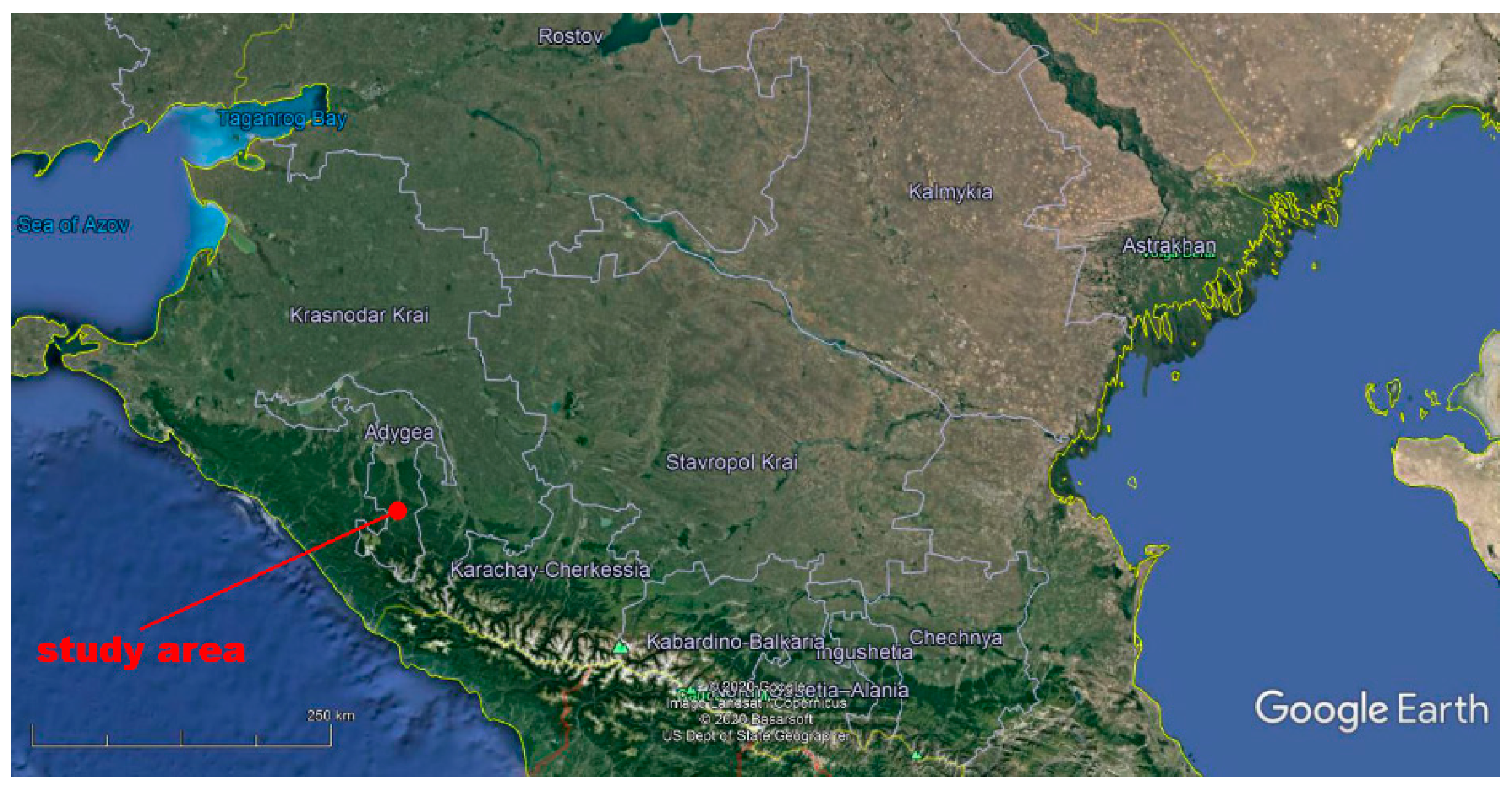
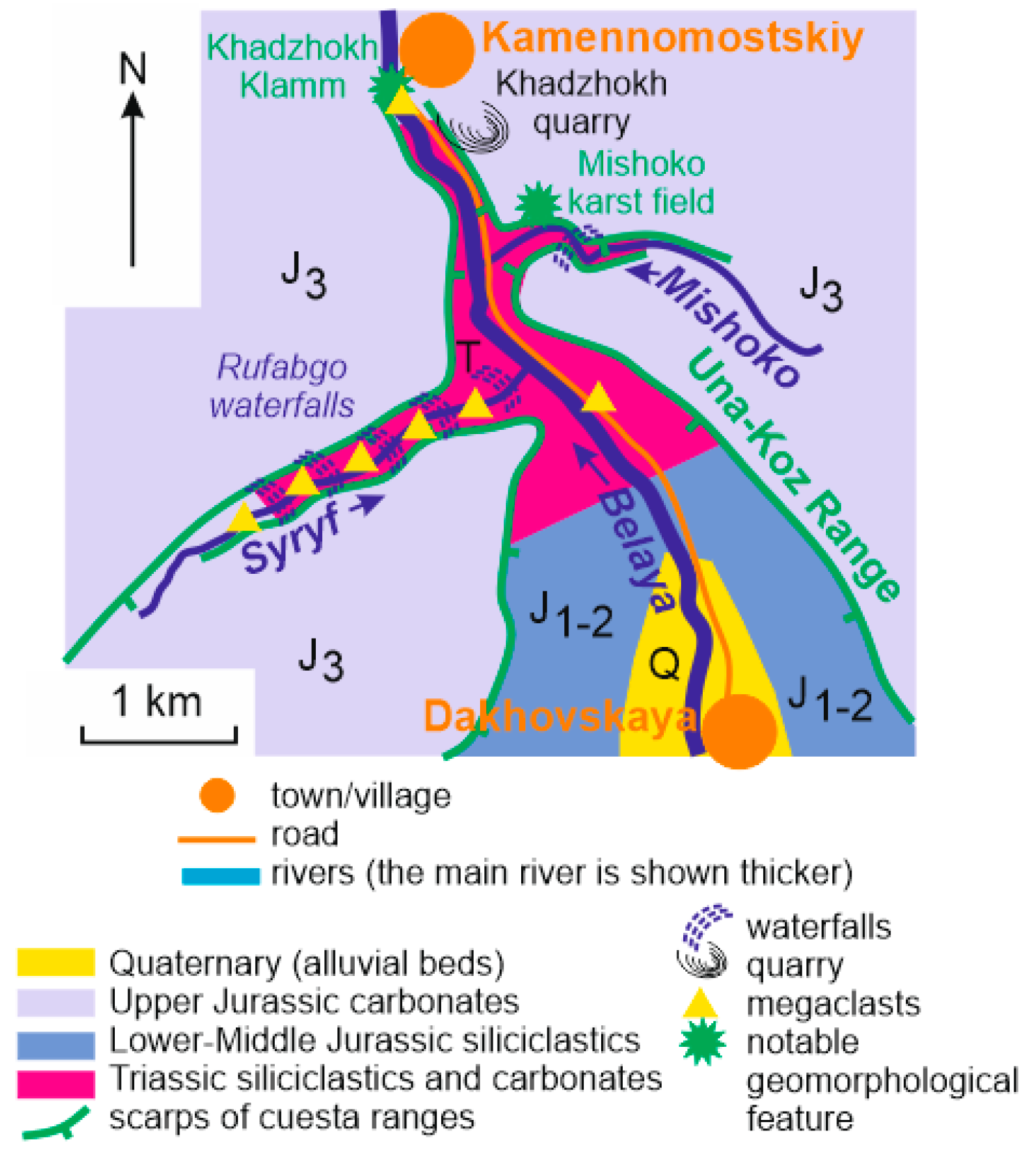
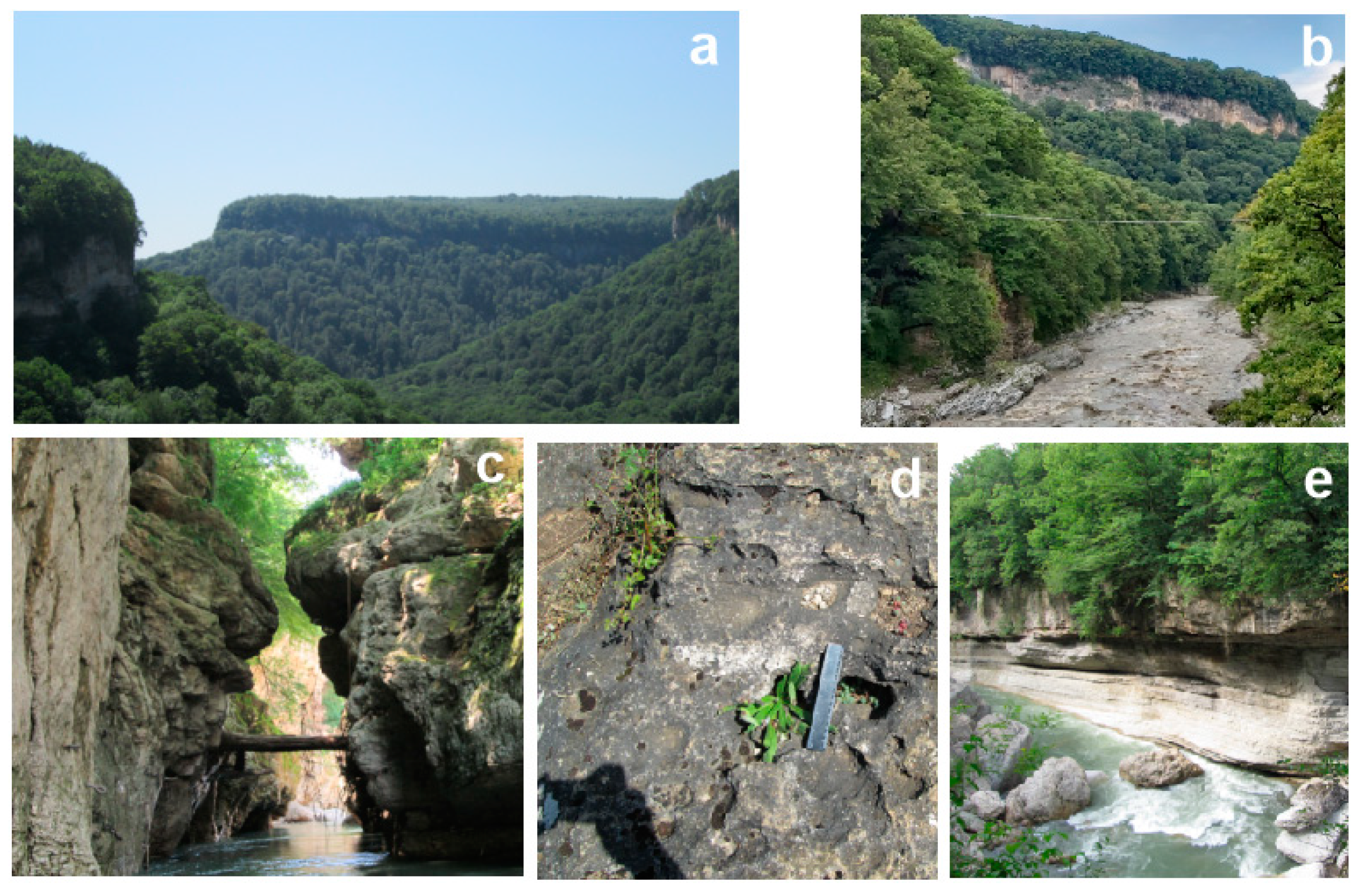
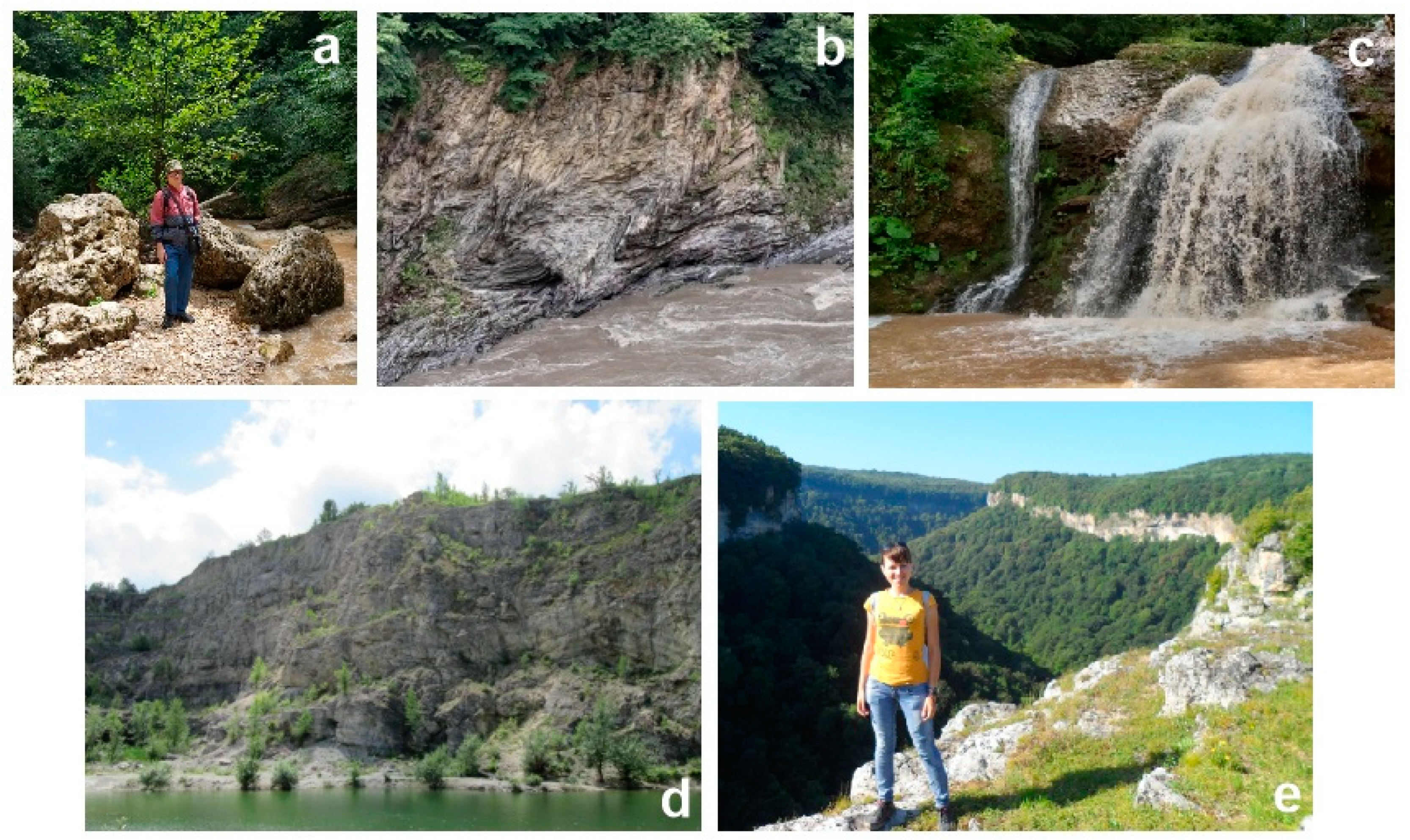
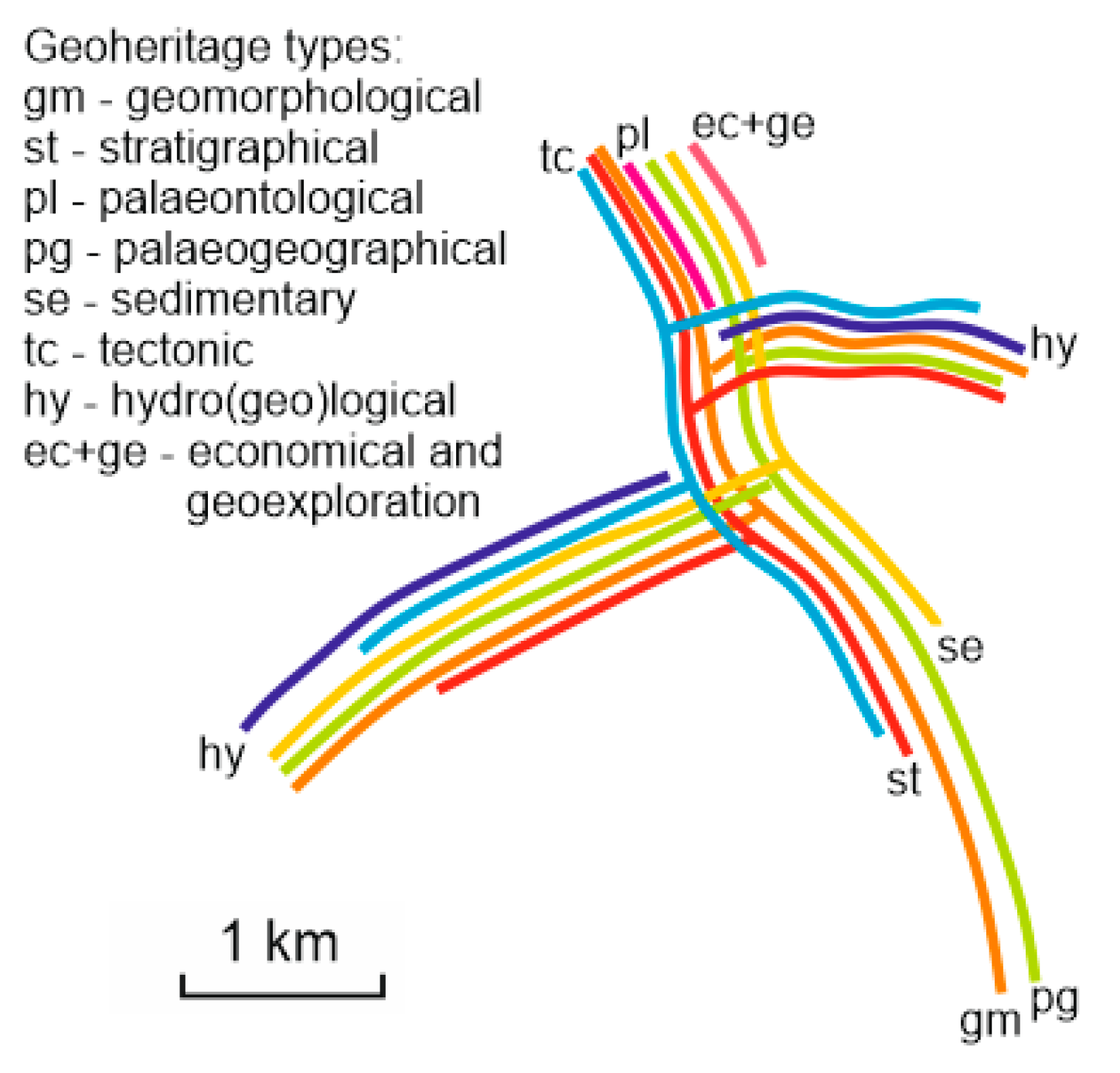
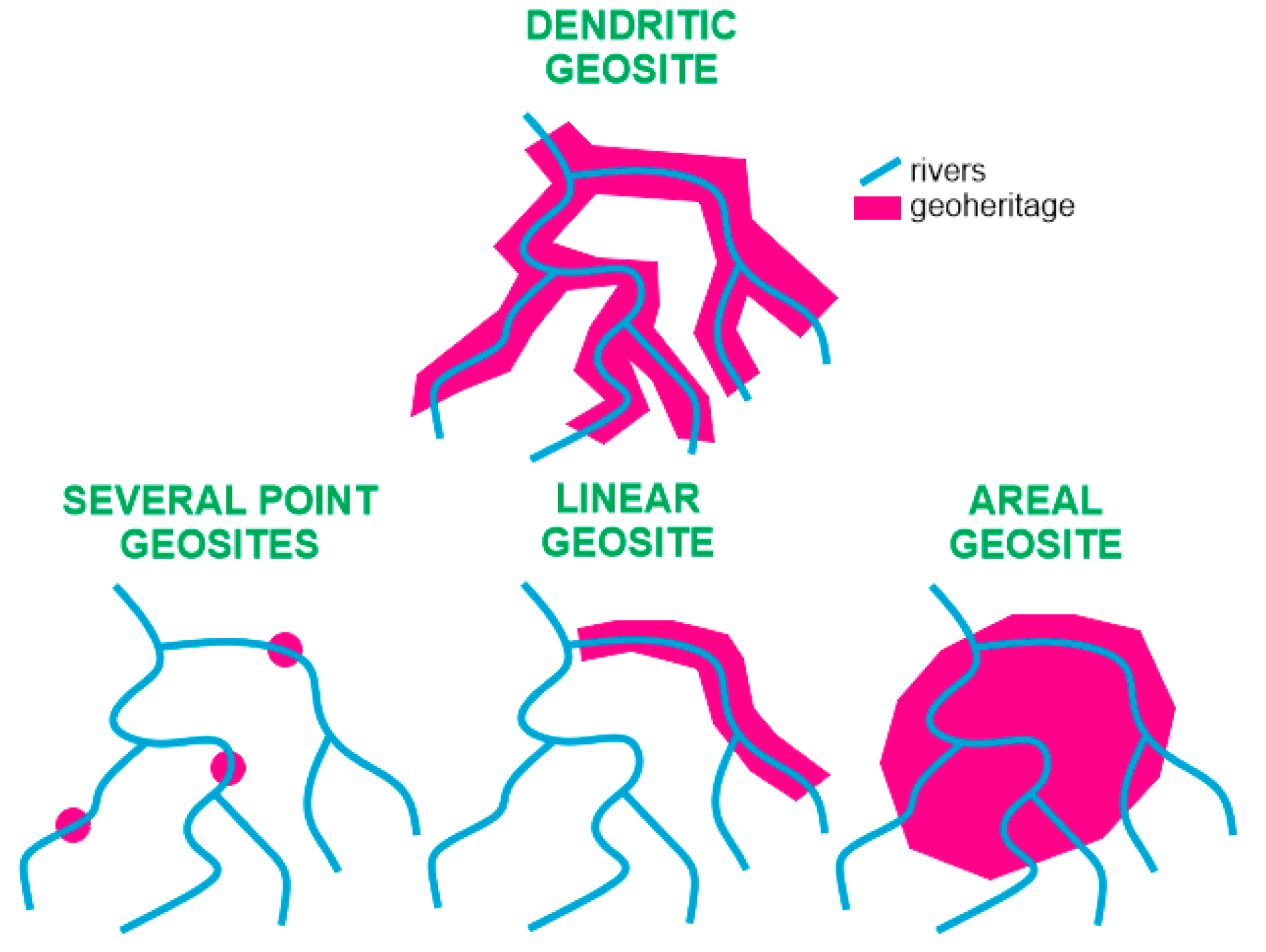
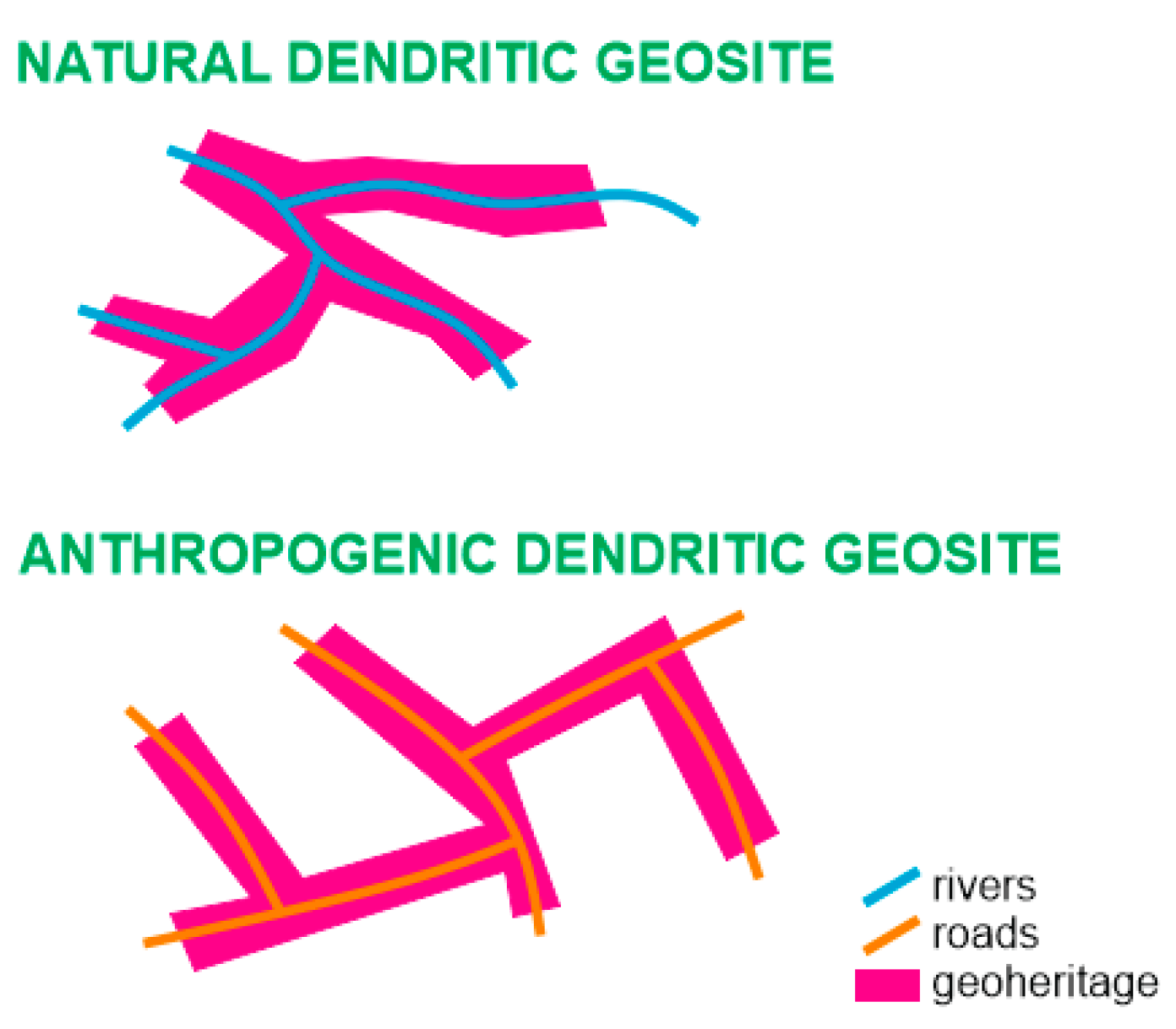
| Criteria | Geosite Characteristics | Scores |
|---|---|---|
| Complexity | 1–2 geoheritage types | 1 |
| 3–5 geoheritage types | 2 | |
| >5 geoheritage types | 3 | |
| Exposure | Small, dispersed outcrops | 1 |
| Fragmentary outcrops | 2 | |
| Lengthy outcrops | 3 | |
| Anthropogenic pressure | Significant modification/big amount of garbage | 1 |
| Small modification/small amount of garbage | 2 | |
| Absent | 3 | |
| Accessibility | Geosite location in remote place, special training is required | 1 |
| Special training is required for visiting some outcrops | 2 | |
| All parts of geosite are easily accessible | 3 | |
| Difficultytounderstand | Only professional knowledge is required | 1 |
| Some professional knowledge is required | 2 | |
| Clear to all people | 3 | |
| Aesthetic properties | Nothing special comparing to the surrounding landscape | 1 |
| Some peculiar features (unusual color of rocks or landform shapes, etc.) | 2 | |
| Aesthetically distinct features, panoramic views, etc. | 3 | |
| Importance to scientists | Low | 1 |
| Medium | 2 | |
| High | 3 | |
| Importance to educators | Low | 1 |
| Medium | 2 | |
| High | 3 | |
| Important to tourists | Low | 1 |
| Medium | 2 | |
| High | 3 |
| Criteria | Geosite Characteristics | Scores |
|---|---|---|
| >5 geoheritage types | 3 | |
| Exposure | Lengthy outcrops | 3 |
| Anthropogenic pressure | Small modification/small amount of garbage | 2 |
| Accessibility | Special training is required for visiting some outcrops | 2 |
| Difficulty-to-understand | Some professional knowledge is required | 2 |
| Aesthetic properties | Aesthetically distinct features, panoramic views, etc. | 3 |
| Importance to scientists | Medium | 2 |
| Importance to educators | High | 3 |
| Important to tourists | High | 3 |
| MEAN | 2.6 | |
© 2020 by the authors. Licensee MDPI, Basel, Switzerland. This article is an open access article distributed under the terms and conditions of the Creative Commons Attribution (CC BY) license (http://creativecommons.org/licenses/by/4.0/).
Share and Cite
Mikhailenko, A.V.; Ruban, D.A.; Ermolaev, V.A. The Khadzhokh Canyon System—An Important Geosite of the Western Caucasus. Geosciences 2020, 10, 181. https://doi.org/10.3390/geosciences10050181
Mikhailenko AV, Ruban DA, Ermolaev VA. The Khadzhokh Canyon System—An Important Geosite of the Western Caucasus. Geosciences. 2020; 10(5):181. https://doi.org/10.3390/geosciences10050181
Chicago/Turabian StyleMikhailenko, Anna V., Dmitry A. Ruban, and Vladimir A. Ermolaev. 2020. "The Khadzhokh Canyon System—An Important Geosite of the Western Caucasus" Geosciences 10, no. 5: 181. https://doi.org/10.3390/geosciences10050181
APA StyleMikhailenko, A. V., Ruban, D. A., & Ermolaev, V. A. (2020). The Khadzhokh Canyon System—An Important Geosite of the Western Caucasus. Geosciences, 10(5), 181. https://doi.org/10.3390/geosciences10050181





